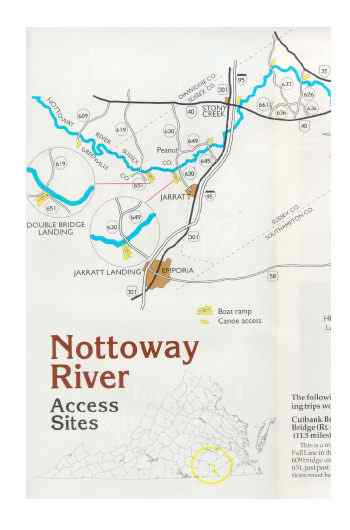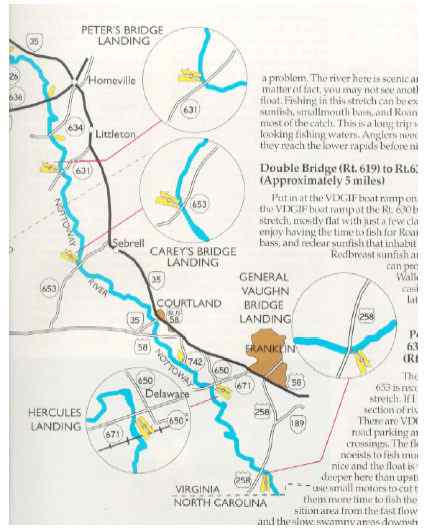Information gathered from Virginia Dept of Game and Inland Fisheries
Contents
Fishing Outlook
I’ve fished quite a few rivers across Virginia and if I had to choose a favorite, I’d have to pick the Nottoway. Actually, if I had to pick a favorite fishing spot, lake, or river, I’d pick the Nottoway. Sure, there are places where you can catch more fish, places where you can catch bigger fish, and places that may be a bit more scenic, but if you like catching fish, with some variety in sizes and species, plus have a little scenery tossed in as well, the Nottoway is worth checking out.
The Nottoway River is located in south central and southeastern Virginia. The river’s length is approximately 130 miles. It begins in Prince Edward and Lunenburg counties and flows southeasterly, forming a boundary for Nottoway-Lunenburg, Brunswick-Dinwiddie, and Greensville-Sussex counties, then meanders across Sussex and Southampton counties to its confluence with the Blackwater River at the North Carolina line, forming the Chowan River.
Above the Route 619 bridge on the Greensville-Sussex County line, the river is generally shallow, clear and fast flowing. There are numerous small rapids that prevent the use of outboard motors and large boats, but canoeists will find some nice float trips. Below Route 619, the river slows, deepens, and darkens as numerous swamps in the Coastal Plain join it. This part of the river, particularly in Southampton County, is large enough for bass boats during normal flows.
For anglers, the river’s fishery could also be divided at the Route 619 bridge. The upper river has numerous redbreast sunfish, smallmouth bass, and Roanoke bass. Below the bridge, bluegill, largemouth bass, black crappie, and channel catfish are more common. In the spring, anglers can catch blueback herring, American shad, striped bass, and white perch migrating upstream from North Carolina.
The fun part of fishing the Nottoway is you never know what you might catch. In one season of sampling fish and angling on the river, I saw 51 different species of fish. It’s not unusual to catch six or eight different species of fish on a given day on one lure. If you want to have some fun, switch lures and baits a couple of time and see how many species you can catch in a day. Every time I fished the river with someone, we ended up having a contest to see who could catch the most species, the most fish, and the biggest fish. The Nottoway is that kind of river. It’s not really a place for trophy fish seekers or those wanting to bring home dinner, though you certainly could. It’s the kind of place where a couple of fishing buddies can have a good time catching and releasing a wide variety of fish. The numbers aren’t bad either. If the water’s clear, you can shoot for catching a hundred fish in a day.
For anglers who don’t have a boat or can’t find a canoeing partner, there’s always wading. The Nottoway can be a great river to wade and fish in the summer and fall. You might want to avoid wading in the spring, because spring flows are typically a little strong, and the river can get muddy after a good rain. In the summer and fall though, the river is typically low and clear. Head for one of the bridge crossing accesses along Rt. 40, or better yet, head up to the Rt. 619 ramp and jump in! On a hot July day, nothing beats standing waist deep in a cool, clean river, catching Roanoke bass and smallmouth bass on an ultra-light rod. If you go wading at the Rt. 619 ramp, don’t worry if the water seems too cold when you step in. You are actually feeling the little spring creek that flows in next to the ramp, which is a lot colder than the river. Once you venture a few feet out into the river, the water’s perfect.
The Nottoway River is a four-season fishery. With its southeast location, the winter isn’t too server on the lower river, and anglers can catch some nice fish. Winter is a great time to fish the lower Nottoway River around Courtland for one pound and larger Roanoke bass. Find the deeper holes and fish on the bottom with small, live shiners. In recent years, a greater number of striped bass have been caught in the winter around the Rt. 258 bridge. To catch these angler favorites, use larger minnows, shad, and jigs.
In late February or early March, depending on water temperature, American shad, hickory shad, blueback herring, and alewife migrate upstream into the Nottoway on their annual spawning run. Southampton County is a good fishing spot early in the run, but most of the bigger American shad head upriver into Sussex County to spawn in the faster flowing water there. Peter’s Bridge Landing (Rt. 631) is a good place to launch a boat and drift shad darts and small spoons for shad. White perch and yellow perch also run up the river in the spring and can provide some good angling. Hungry striped bass will follow the shad and herring schools upstream and add some excitement to a quite day on the river. By late spring, largemouth bass and redear sunfish are active in the backwaters downstream of Courtland and are targeted by many anglers. The lower Nottoway River is an excellent location for one-pound plus size shellcrackers. Lily pad beds along the shore and in backwater sloughs hold some of the bigger fish.
The summertime offers good fishing throughout the river, but anglers will typically head either further upstream or further downstream depending on their preferred species. As the river gets warmer, many species will head upriver to find cooler, flowing water, while other seek out deep, quite pools in the lower river. Around the Fall Line, waders and canoeists can cast small spinners and floating crankbaits to entice smallmouth bass, Roanoke bass, and redbreast sunfish. Downriver, where channel catfish are biting well, bluegill and bass fishing can still be good. Longnose gar school in the pools and can be caught easily on live minnows. Gar will also hit slow moving surface lures in the summer. Fishing in Sussex County is especially rewarding at this time of year because you can catch a little bit of everything.
In the fall, fish will be fairly well distributed throughout the river. Water levels can be low and fish will have found the deeper pools to hang out in. The lower river provides better action as the water cools and fish start moving down to their winter pools. Basically, Nottoway fishing works on a cycle. Start the year far downstream; follow the shad upriver in the spring; go further up for the summer; and then come back downstream as water temperatures fall again.
There are a half dozen paved ramps and about a dozen canoe access areas along the Nottoway, providing boaters and anglers with a wide variety of float trips. There are more access sites and more water in the lower river. The upper river is sandy and shallow, so it is more suited to wading than boating. The first public boat access on the river is at Nottoway Falls on Route 49, south of Crewe (downstream of the Fort Pickett military reservation, the river is deeper and rockier). Canoes can be launched at Rt. 613 and each bridge downriver (except I-85) in Dinwiddie County. In Greensville County and further downstream, there are more public ramps and parking areas for anglers and boaters to enjoy the river. Give the Nottoway a try and I’ll bet it becomes on e of your favorites too. The scenery is nice and the float is very easy. The river is deeper here than upstream, so anglers can use small motors to cut the float time, allowing them more time to fish the good spots. This transition area from the fast flowing waters upstream and the slow, swampy areas downstream provides anglers the chance to catch a little bit of everything.
Fishing Limits
Black Bass (smallmouth and largemouth)
- 5 per day in aggregate
No length limits
Roanoke Bass
- 5 per day in aggregate with rock bass
- No Roanoke or rock bass less than 8 inches
Sunfish
- 50 per day in aggregate
- No length limits
Crappie
- 25 per day
- No length limits
Channel Catfish
- 20 per day
- No length limit
Maps

